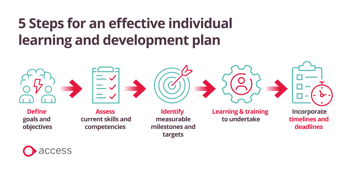A Guide to Creating Individual Development Plans for Employee Growth
Nurturing employee growth is crucial for retaining and developing top talent within your organisation, and long gone are the days of a one-size fits all approach to learning. There is now a demand for personalised and targeted training which can be identified through Individual Development Plans (IDPs) and can demonstrate to an employee that you are invested in them.
In this article, we are going to discuss what IDPs can help your employees achieve, how to write an IDP and why using a personalised learning platform can help organisations create IDPs at scale.
Understanding Individual Development Plans
Let’s firstly take a look at what individual development plans are.
An IDP is a personalised learning plan or roadmap which is specific to each individual to help them grow in a professional setting. It's essentially an action plan which assesses current job performance against the specific expectations of their role and outlines how they can progress.
An IDP requires collaboration between employers and employees in order to define goals that benefit the learner, the team and the company as a whole.
If an employee is looking develop their career they can use the IDP to measure their performance and create a clear path to meet their goals. By documenting the plan with timeframes and deliverables, it creates a template that can easily be referred back to.
Benefits of implementing individual development plans for organisations include:
- an uplift in productivity
- supporting professional development
- improving overall morale.
What is the difference between individual development plans and individual learning plans?
While the two are similar, learning plans and development plans differ in their focus.
Learning plans focus on increasing job-specific knowledge and skills, whereas development plans encompass personal and professional growth initiatives that prepare employees for future roles and responsibilities. In an individual learning and development plan, the two are combined to create a robust strategy which explores both what the employee needs to work on and how they can achieve these aims.
5 key components of an effective individual learning and development plan
Creating a strong individual learning and development plan requires an organised and detailed approach including actionable steps that align with both personal and professional goals. Let’s take a look at what is needed to carry this out successfully.
5 steps for an effective individual learning and development plan

1. Defining goals and objectives
Identify what the employee wishes to achieve during their career within your organisation. By gaining insight into their ambitions and objectives, you establish a strong foundation for constructing an IDP that remains focused. Examples of goals and objectives include:
- moving into a more senior position
- taking on additional tasks
- expanding their knowledge base on relevant topics
2. Assessing current skills and competencies
Reviewing the employee’s current skillset is essential to help shape their individual learning and development plan. It is important to remain objective and discuss skills the employee excels at alongside where there may be room for improvement or where additional support is required for them to progress.
Utilising both their strengths and skills gaps ensures that a well-rounded plan is created.
3. Identifying measurable milestones and targets
Set clear and measurable milestones and targets that align with the employee's goals as determined during the assessment. This could include skills gaps or areas that they perform well in but want to progress further. These milestones act as checkpoints to track progress and ensure the employee learning and development plan stays on course.
4. Learning and training to undertake
Identifying the learning and development or training activities needed to help your employee bridge the gap between current skill levels and where they want to be gives them a clear path to reach their targets. Whether you have training opportunities in-house or need to outsource specific content, this ensures that the right training is undertaken by the right people.
5. Incorporating timelines and deadlines
Including reasonable and achievable deadlines will help to keep the IDP on track and ensures that progress is made in a suitable timeframe. It encourages the employee to stay accountable for their own development and provides a sense of purpose as they are working towards these agreed timelines.
Career development software can provide many benefits for employees and managers. Find out more.
How to create an IDP: What you need to know
Now we've established what components should be included, let’s look at how to create an IDP.
Developing a workplace learning plan for an individual requires a systematic approach which hinges on gathering specific information before you can begin writing the plan.
In the 2025 LinkedIn Workplace Learning Report, it was reported that employee engagement and retention are the most common ways to measure the business impact of career development.
How to write an IDP: Essential content and framework
Let’s now look at how to write an IDP, focusing the content that should be included for the creation of a successful employee learning and development plan. Using this framework as a guide can result in both employee and organisation alignment.
Professional goals and aspirations
Setting out personal goals will give the IDP a strong framework that the employee can refer back to. These should be relevant to the employee’s job role but also outline their aspirations. Having specific career goals will help with linking the employee up with opportunities for development and an action plan for success.
Strengths and areas for development
Write up what has been discussed to confirm where your employee’s strengths and competencies lie. Outline where the employee is currently doing well alongside where they made need additional support in order to succeed or progress.
Opportunities for development
Here is where you can detail the learning resources and tools available within your organisation to present a clear path for your employee to progress and grow. These could encompass a wide range of formats, such as webinars, podcasts, or courses. Based on the personalised learning strategies identified to understand their specific learning styles, you can tailor it to how they best learn and engage.
Action plan
Document a framework for ongoing progress monitoring, feedback, and regular check-ins to ensure that the IDP continues to align with the employee's evolving needs and goals.
Include a timeline to provide both structure and accountability.
This can help your employee remain focused on their personal and professional growth. Short-term and long-term goals should include specific deadlines or checkpoints.
Example of an Individual Learning Plan
Now we have discussed how to create an IDP and what's involved in the process, let’s look at some IDP examples for employees.
We will look at the role of marketing coordinator and sales executive and with suggested goals that can help them progress within their roles.
This will provide IDP ideas for employees looking to enhance their professional growth and align their development with specific job roles.
Leveraging a personalised learning platform
A personalised learning platform is a unique space where employees can see and track their progress towards specific goals. From an organisation’s perspective, a holistic overview of the training and support needed to provide the most appropriate resources across the workforce is gained.
When there is a large workforce with an array of different departments, there is undoubtedly a lot of work in creating plans that are tailored to each individual. Utilising personalised career development software solutions ensures that the required level of detail and care is taken when producing IPD’s at scale.
By using advanced technologies to assess skills and map out suitable learning methods for development, individual development plans can be created for all employees, no matter their role or seniority. This inclusivity is crucial, as it ensures that every member of the organisation, regardless of their role, can receive the guidance and resources they need to thrive. Having the technology to assist in this task will streamline the process and ensure the right information is tracked and made available when needed.
Find out more about personalised learning and how it can take development to the next level.
Final thoughts
In a world where talent development is crucial, Individual Development Plans are the key to creating a tailored approach to learning, utilising the full potential of employees and organisations alike. By using personalised learning solutions, like Access Career Development, you can empower your employees and create robust plans at scale, meaning that no matter the size of your organisation, every employee’s career goals and aspirations can be nurtured.

